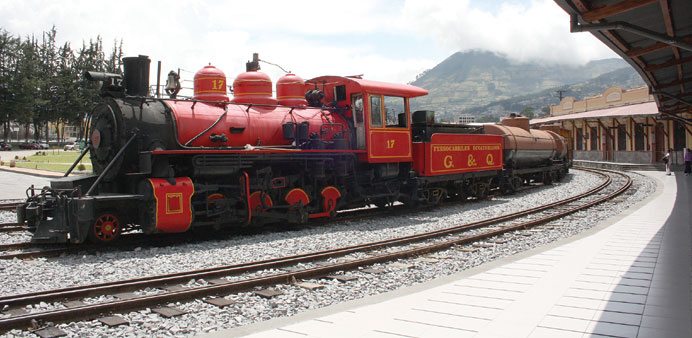No longer used on the incline: one of Ecuador Railways’ stunning old-fashioned red-painted steam locomotives in Chimbacalle Station in Quito.
By Christina Horsten
Two long pips of the whistle are followed by a series of jerks and the steam engine slowly pulls away. The grey seats in the two wooden-panelled carriages are all occupied.
The train has hardly set off and already passengers are brandishing cameras and camcorders. Before them lies a short journey through the Ecuadorian Andes — one of the steepest rail-trips in the world and also one of the most dramatic. In the space of 30 minutes passengers travel from Alausi to Sibambe, down the face of the infamous “Nariz del Diablo” or Devil’s Nose.
There are precipitous switchbacks where the train goes into reverse three or four times, zigzagging down the mountainside. It works its way heroically down into a cleft in the rock, descending from 2,300m to 1,800m above sea level. The trip begins in the nondescript little town of Alausi where the train rolls out past pastel-coloured houses and restaurants.
Alausi is dominated by an oversized statue of San Pedro and most tourists only come here in order to leave as quickly as possible on the famous train. The big rock known as the Devil’s Nose is just a few hundred metres away as the crow flies and exerts an almost irresistible attraction on those who come here.
“I always wanted to take a ride on this train,” says a baseball-capped tourist from the United States, leaning out of the window to capture the scene on film. “This is the highlight of my Ecuador tour.”
Beyond Alausi is a broad green valley of tended fields and cacti which does not betray the steep 1 in 18 gradient of the descent ahead. The conductor uses the interval to recount the history of Ecuador’s great little railway.
It was the brainchild of President Gabriel Moreno who decided in the 19th century that the capital Quito should be linked by rail with the Pacific settlement of Guayaquil, now a flourishing economic hub.
“Before that the two cities were more or less cut off from each other,” said the conductor who wears a smart blue uniform. “Letters and postcards between them took weeks if not months to arrive.”
Moreno’s successor as head of state, Eloy Alfaro, oversaw completion of the line, employing US engineers, and in 1908 the first train made the trip from Guayaquil to Quito.
Building the 12km section from Alausi was a remarkable feat of engineering skill. Much of the route had to be blasted from the rock face and the dangerous working conditions meant that Ecuadorian labourers were loathe to work here.
In the end, 4,000 Jamaican navvies were hired to finish the job and more than half died while toiling on the mountainside.
Their tragic fate was what gave the rock its name. “The Americans said you needed to enter a pact with the devil to build a railroad here and that’s why they call it Devil’s Nose,” said the conductor.
Meanwhile, the locomotive has chugged to the edge of the high plateau and from now on the drop feels almost vertical. A safer diesel locomotive takes over for this section. After a series of technical checks the driver, his assistant and a “frenero,” a man whose sole job it is to keep an eye on the brakes, guide the train down slowly through the zigzag turns.
Wide-eyed passengers gaze from the windows with a mixture of fear and excitement as the train runs perilously close to the sheer drop alongside it. The danger is palpable and there have been accidents in the past. Passengers used to clamber onto the carriage roof for a better view and in 2007 two Japanese tourists were killed aloft after they were hit by a cable dangling over the line.
Since then passengers must stay inside. There was not enough space on the mountain for a line where the train turns at each switchback, so instead it reverses at the staging areas. When the train has finished its descent into the valley, the driver halts it around 100m beyond the Devil’s Nose to let passengers alight and take photos. “That was really amazing. Much more exciting than I imagined,” exclaims the American tourist.
Garces takes a brief break before piloting his train back up the zigzag course to the top. “For the past few months we’ve been doing this trip every day and it is pretty exhausting work. On the other hand, it really is great that so many people are coming to Ecuador and joining us for the ride.”
The daily trips are evidence of a railway revival that has begun in Ecuador. The state railway company Ferrocarriles del Ecuador is taking on new staff, lines are being upgraded, stations are being renovated and modern trains are coming into service. Instead of the neglect of past decades, there is pride.
Passengers can buy souvenirs at many stations, bright red drinking bottles, bags, stickers and even a conductor figure as a cuddly, soft toy — the portly version with moustache carries the name “Don Ferro” and there is a thin one called “Pepe”.
Competition among South American countries to lure tourists is intense and there are other unusual rail rides available in countries such as Argentina and Chile. A luxury train also recently begun operating in Ecuador, snaking its way some 450km from the Andes to the Pacific coast.
Not all aspects of the rail boom have gone down well. Many drivers lament the short duration of training courses for new staff, poor wages and above all, expensive fares.
A return trip along the Devil’s Nose route section costs around $20. Around 90% of those riding the trains are foreigners, according to a spokesman. Ecuadorians generally take the bus up or down the mountain. — DPA

